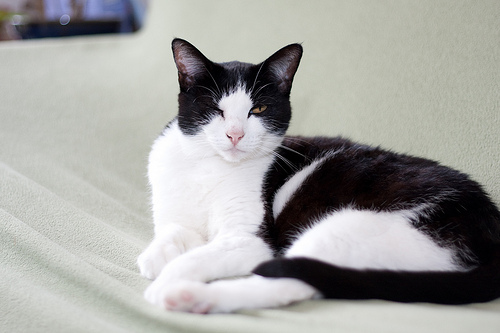
“Ringworm” (Dermatophytosis) is a fungal infection that affects the hair, nails, and superficial layers of the skin. Ringworm infections can be found on all domestic animals, as well some wild animals. It is by far the most prevalent fungal infection of the skin in cats and dogs. Pet owners should be aware of the clinical signs of ringworm because it is a disease that can be passed on to humans.
What is ringworm?
Ringworm is a term used to describe certain types of fungus that live on the skin, known as “dermatophytes”. There are no worms involved in ringworm infections. The most common species of dermatophytes found on cats and dogs are Microsporum canis, Trichophyton mentagrophytes, and Microsporum gypseum.
Dermatophytes can found in the environment, or can be carried by animal hosts. Some animals will carry ringworm without every showing any signs of skin lesions; however, this does not prevent them from transferring the disease to other animals or people.
How did my pet become infected with ringworm?
There are multiple ways of becoming infected with ringworm. Ringworm may be transferred by direct contact with an infected animal, or indirectly via dermatophytes free in the environment or on objects such as combs, bedding, and brushes. Even if your pet has been exposed to ringworm, it will not necessarily develop skin lesions. Clinical signs are more likely to occur in younger animals, animals with skin defects, and those with weakened immune systems.
Are pet owners at risk of contracting ringworm from their pets?
Yes, people can contract ringworm from animals. The people at greater risk for ringworm infection are the young, the elderly, and those with suppressed immune systems. If your pet is infected, minimize contact with it until its signs have resolved. If you develop any lesions consult a doctor for advice on the proper treatment of ringworm.
How can I recognize the signs of ringworm?
The signs of ringworm can vary, but most animals have the classic ringworm lesion: a circular red area of hair loss which is surrounded by broken hair and scale at the edge of the lesion. The lesions typically heal from the center as they enlarge peripherally. Other signs of ringworm may include patchy hair loss, itching, inflammation, and infection of the nails. Always consult a veterinarian to confirm that your pet does indeed have ringworm.
How does a veterinarian diagnose ringworm?
Diagnosing ringworm is not always straightforward. Other skin diseases may mimic the signs of ringworm. The veterinarian will need to get a complete history from the owner, perform a physical exam, and will examine your pet’s coat with the use of a Wood’s lamp.
A Wood’s lamp is a UV lamp that causes infected hairs to fluoresce. Hairs infected by certain strains of dermatophytes (e.g. Microsporum canis) will appear apple green under a Wood’s lamp.
While positive fluorescence is strongly suggestive of a ringworm infection, a negative result cannot rule out ringworm infection, as some strains of ringworm do not fluoresce. There are three other methods that your vet may employ to further investigate a suspected case of ringworm:
1. Microscopic examination: hairs are examined under a microscope for the presence of fungal spores
2. Fungal culture: a sample of hair and skin are placed on a special culture medium in an attempt to grow the fungus that causes ringworm. This is a time-consuming process as it can take as long as 10 days for the fungal culture to grow.
3. Skin Biopsy: this is an effective and rapid mean of confirming a diagnosis. Biopsies are taken from around the periphery of the lesion and sent to a lab for analysis.
What is the treatment for ringworm?
It is important to remember that ringworm can survive on animals and in the environment. Thus, both the infected pet and its environment should be treated in order to halt the spread of infection.
1. Oral Medication:
Griseofulvin is the drug of choice for ringworm infections.
• It should be fed with a fatty meal or some corn oil to increase its absorption.
• Griseofulvin should never be given to pregnant animals and cats that are FIV-positive.
• Common side effects can include lethargy, loss of appetite, vomiting, and diarrhoea
Itraconazole is another drug that is increasingly used for ringworm infection.
• The efficacy of the drug is similar to griseofulvin, but it can be prohibitively expensive
• Should not be given to pregnant animals
• The most common side effect is nausea
Ketoconazole is a similar drug to itraconazole.
• Ketoconazole is infrequently used due to a high incidence of adverse side-effects and the resistance of some strains of ringworm to it.
2. Environmental treatment: Spores can survive for years in the environment. In order to minimise the spread of infection to other animals and people, it is imperative to effectively treat the environment. If possible, brushes, combs, and bedding should all be discarded.
Dilute bleach is an effective disinfectant for surfaces around the house. Vacuum-cleaning should be performed daily and disinfection weekly until the infection is eliminated.
3. Topical therapy: the jury is out about the efficacy of topical therapy. Traditionally, infected animals have been clipped and treated with topical antifungal preparations. Some effective treatments are enilconazole, lime-sulfur dips, and miconazole/chlorhexidine shampoo (Malaseb).
However, some studies have shown that clipping may exacerbate signs and spread infection. Always ask your vet before utilising any topical treatments.
Is there a vaccine for ringworm?
There is a vaccine available in the United States for use in cats, but it is not widely used. The vaccine can reduce the clinical signs of infection, but your cat will still be a carrier. It is also for use in cats that are already infected, as an adjunctive therapy.
Will ringworm just go away by itself?
Ringworm infections can resolve by themselves over several months. Pets should still be treated though, as therapy will hasten recovery and reduce environmental contamination.
(photo: iadk)